|
PRC-64/Delco Battery Box Insert.
|
Introduction:
The PRC-64/Delco 5300 original battery is very hard to find, the battery number is a BA-1509/PRC-64 and is described as a Battery Dry, 31.5 volts. After giving up my search for the battery I decided to make a simple battery tray system using standard 9 volt connectors, AA battery holders with a scrounged BA-48 battery connector as the main connector from the tray to the radio. The tray is designed to fit into the orginial Delco battery box and make connection as the tray is fully inserted. I was getting tired of fooling around recharging nicads and felt that for reliability the AA's were a better choice. I searched for cell holders and connectors that were easily obtained and finally decided on Radio Shack OTS(off the shelf) items. Their rugged 9 volt battery connector is a very good quality and the 4 and 8 cell battery holders are fairly well constructed.
Circuit Overview:
I diode isolated all
power circuits to prevent the operator from accidentally trying to hook
up those pesky 9 volt connectors backwards thus damaging the radio.The
entire battery tray slides in and out of the Delco battery compartment
making it very easy to service the batteries. The transmitter was designed
for 24 volts but I am running it off of 18 volts via one 8 cell and one
4 cell AA battery pack wired in series. The receiver is powered by a 4
cell pack with one cell disabled. The power for the audio section of the
transmitter is obtained via a dropping resistor from the 18 volt pack.
I abandoning the idea of using 24 volts and having a 5 volt and 12 volt
regulators, too complicated and using Bill Lear's system of KISS, I stuck
with the present system.
Scrounge a connector from a BA-48 battery or similar
dry dry cell. Solder on new leads with 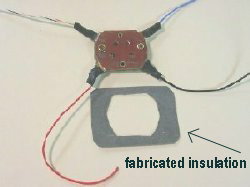 spaghetti
insulation.
spaghetti
insulation.
Additional insulation for the connecting leads with a cut out for the
connector can be fashioned from a piece of oil paper or plastic. Those
plastic bubble packs from the hardware store that take ten minutes to
open and cut your hands to pieces have thin plastic that can be used.
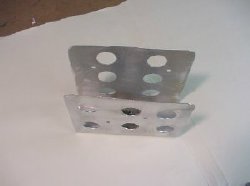 Fabricate
a U shaped chassis for your pack. Holes were cut in the sides of the chassis
to aid in removing the pack from the Delco battery compartment and to
reduce the overall weight for tactical air shipment.
Fabricate
a U shaped chassis for your pack. Holes were cut in the sides of the chassis
to aid in removing the pack from the Delco battery compartment and to
reduce the overall weight for tactical air shipment.
|
Dimensions of the k4che Delco battery box are shown here.
|
A small bracket was formed 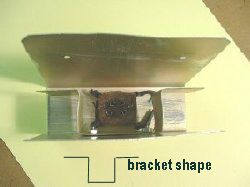 to
provide protection for the connector and to hold the battery boxes to
the left and right of the connector. This piece is secured with 4-40 flat
head screws to the side. This bracket forms a small center compartment
that can be used for storage of accessories but remember to protect the
top of the BA-48 connector pins from shorting against any accessories
that you store in this area.
to
provide protection for the connector and to hold the battery boxes to
the left and right of the connector. This piece is secured with 4-40 flat
head screws to the side. This bracket forms a small center compartment
that can be used for storage of accessories but remember to protect the
top of the BA-48 connector pins from shorting against any accessories
that you store in this area.
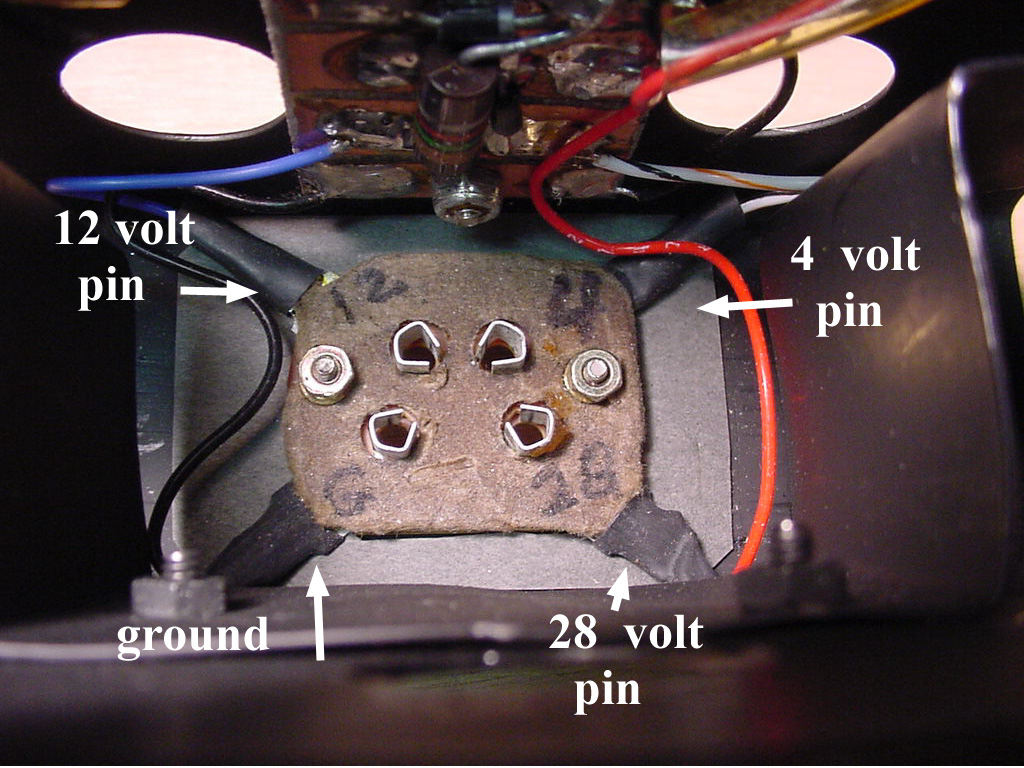 The
BA-48 connector is in place and the additional insulation is positioned
underneath the leads.
The
BA-48 connector is in place and the additional insulation is positioned
underneath the leads.
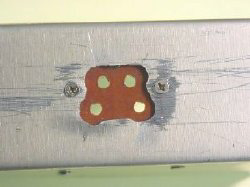 Important:
Flat head screws are used to mount the BA-8 connector..
Important:
Flat head screws are used to mount the BA-8 connector..
The bottom of the chassis has to be "flat"
to insure that the connector will mate with the radio. You can make a
cutting pattern outline on the bottom of your box by putting a small piece
of carbon paper over the radio pins and press down with your uncut box,
the pins will now be marked on your box. Drill and get out the ole rat
tail file.
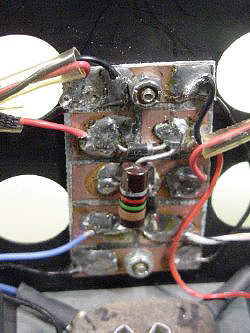
A distribution panel was made using a "carved"printed
circuit board. Use a sharp hobby knife or Dremel tool to create rectangular
shaped pads or "islands"for the connections.
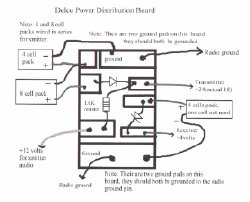
 The receiver uses a total of 3 cells contained in a 4 cell pack,one
cell holder is not used and contains a dummy cell. The dummy cell
is constructed by using a discharged battery and running a wire from
the top to the bottom of the battery. This technique helps the holder
keep it shape and I also found that trying to solder to the holder
and install a jumper destroyed the connectors as the plastic melted.
The total voltage for 3 cells is 4.5 volts, I diode isolated this
for reverse voltage protection and got an additional voltage drop
and ran the receiver on the resulting 3.8 volts.
The receiver uses a total of 3 cells contained in a 4 cell pack,one
cell holder is not used and contains a dummy cell. The dummy cell
is constructed by using a discharged battery and running a wire from
the top to the bottom of the battery. This technique helps the holder
keep it shape and I also found that trying to solder to the holder
and install a jumper destroyed the connectors as the plastic melted.
The total voltage for 3 cells is 4.5 volts, I diode isolated this
for reverse voltage protection and got an additional voltage drop
and ran the receiver on the resulting 3.8 volts. |
250.jpg)
The transmitter is powered from 18 volts comprising of a 4 cell and a 8 cell pack wired in series. Each 4 cell pack will be installed vertically in the side compartments , the 8 cell pack will lay on top.
The distribution board is mounted on the side near the BA-48 connector.A 1400 ohm dropping resistor was used to supply the 12 volts for the audio section. The tray was painted black because I didn't want any reflections during night operations while servicing the battery.
A Word of caution about the small cell battery cases, they have exposed terminals when the main 9 volt male-female connector is not connected. In addition all of the packs that I used had exposed rivet's, if you leave the batteries in their cases then store the cases properly. Remember that the AA battery rating when new is approximately 1500 to 2000 mAh. Best bet is to remove the batteries or at least remove one of the batteries to disable the pack. Those small 9 volt batteries that float around on your work bench are rated at 500 mAh and are also dangerous, don't just throw them in the trash when you think they are slightly weak, cover the terminals with tape.
Here are a few links for small battery data:
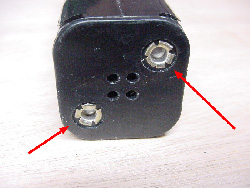
Insulate all
exposed rivets
.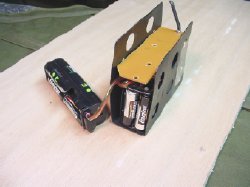 The plastic divider is in place.
The plastic divider is in place.
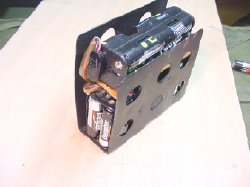
The completed project. Leads to the battery case connectors
are covered with clear tubing. The small plastic divider piece is in place
to separate the first layer of batteries (left and right batteries) from
the upper 8 cell pack .
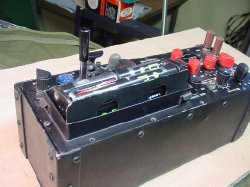 All
the batteries are in place and there is still plenty of room left when
the cover is put on. Notice that part of the tray sticks above the battery
box for ease of removal.
All
the batteries are in place and there is still plenty of room left when
the cover is put on. Notice that part of the tray sticks above the battery
box for ease of removal.

Battery box cover in place, latches secure.
PARTS LIST: (partial, Radio Shack)
270-324"heavy duty" battery connectors
270-324, 8 Cell battery pack
270-407A, Diodes 276-1102
(1N4003) or use a 276-1103
(1N4004) The transmit audio
dropping resistor that I used was a 1 watt
1600 ohm, its not very critical. If you
can't find a 1 watt, try experimenting
with some one half watt resistors in parallel
such as two 3K resistors. .